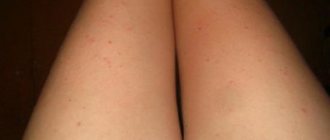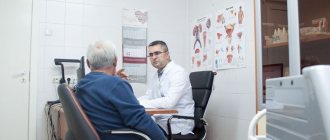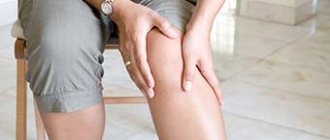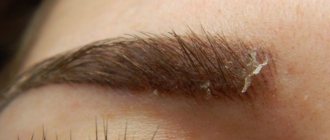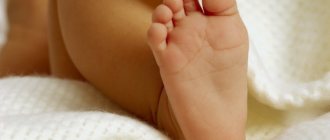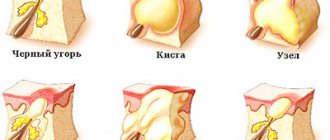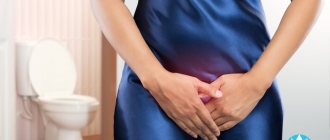Hello! Today Natalya Smirnova is with you, and I want to talk in more detail about such a seasonal (though not always) problem as cracked lips. Small cracks on the lips only at first glance seem like a minor nuisance. There is very thin skin on the lips, and if problems arise with healing, then we can neither eat normally nor laugh, and in general this is an aesthetically unpleasant phenomenon. In addition, a small crack is an open gate for infection; if this is often ignored, then the appearance of a large deep crack, as they say, is just a stone's throw away.
Today Natalya Smirnova is with you, and I want to talk in more detail about such a seasonal (though not always) problem as cracked lips. Small cracks on the lips only at first glance seem like a minor nuisance. There is very thin skin on the lips, and if problems arise with healing, then we can neither eat normally nor laugh, and in general this is an aesthetically unpleasant phenomenon. In addition, a small crack is an open gate for infection; if this is often ignored, then the appearance of a large deep crack, as they say, is just a stone's throw away.
Why do wounds and cracks appear on the lips, how to treat them and how to prevent the appearance of new ones? Of course, you can immediately contact a specialist so that the doctor can prescribe treatment, but for many people this can cause difficulties for a number of reasons. It’s not always possible to get time off from work to visit the clinic, and in general, such visits do not bring positivity into our lives. And going to a paid medical center with such a problem somehow doesn’t even occur to me, the problem seems trivial, at first glance , so few people want to pay money for a consultation. So, as an ambulance for your lips, you can use proven pharmaceutical drugs and traditional methods. So, first things first.
Of course, you can immediately contact a specialist so that the doctor can prescribe treatment, but for many people this can cause difficulties for a number of reasons. It’s not always possible to get time off from work to visit the clinic, and in general, such visits do not bring positivity into our lives. And going to a paid medical center with such a problem somehow doesn’t even occur to me, the problem seems trivial, at first glance , so few people want to pay money for a consultation. So, as an ambulance for your lips, you can use proven pharmaceutical drugs and traditional methods. So, first things first.
Features of the problem
Healing lip ointment has a beneficial effect when ulcers appear due to traumatic exposure. It helps in cases where problems with the skin of the lips begin due to biting soft tissues, improper brushing of teeth, colds, and herpes.
Damage to the lips most often occurs for the following reasons:
- dry indoor air;
- habit of licking and biting lips;
- allergies to cosmetics, hygiene products and all kinds of drugs;
- dryness of the epithelium due to unfavorable natural conditions;
- deficiency of vitamins and microelements;
- diseases of the gastrointestinal tract;
- mechanical damage to the lips.
Using only ointment for lip problems is not enough. It is important to find out the cause of the formation of wounds and cracks on the skin and eliminate it.
Appearance of dry skin during pregnancy
This problem often worries pregnant women. Often, even an ordinary cream or ointment cannot overcome the problem. All this happens due to changes in hormonal levels, which in turn causes toxicosis and vitamin deficiency. Therefore, the solution here is to eliminate the problem by adding vitamins and nutrients.
Lack of iron or hemoglobin also leads to such consequences. Therefore, this cause must be treated by intervening and influencing the body from the inside.
What is suitable for healing
When choosing lip products, you need to pay attention to certain points. Firstly, the ointment must contain components that create a protective layer and retain moisture. These include beeswax and paraffin.
It is ideal if the composition contains hydrants, that is, substances that attract and retain moisture. These include coconut oil, hyaluronic acid, propylene glycol and so on. Secondly, for those who are often exposed to sunlight, experts advise using products with an SPF factor. And it is also important to give preference to preparations with vitamin complexes, oils and plant extracts.
Ointment "Solcoseryl"
Healing ointment for lips "Solcoseryl" is a complex product that accelerates cell regeneration processes. The main active ingredient is hemoderivat, that is, the blood of calves. Proteins are removed from it in the laboratory. This processing method makes it possible to preserve biological properties and at the same time eliminate the risk of prions (microscopic protein causative agents of dangerous ailments).
Hemodrivat is part of the group of activators of regeneration processes. Thanks to it, the process of cell reproduction and division is accelerated, so the skin is restored much faster. The substance participates in cell metabolic processes, stimulates the transport of oxygen, glucose and other nutrients.
Solcoseryl healing lip ointment contains:
- hemodialysate;
- cholesterol, which is used to create cell membranes;
- cetyl alcohol, which saturates the skin with moisture and retains it even in deep layers;
- Vaseline, which acts as an auxiliary component and forms a protective layer on the lips.
The main contraindication to the use of the product is hypersensitivity to the components. The ointment is safe to use and has no contraindications for age. It can be used by pregnant and lactating women.
Ointment "Bepanten"
Ointment for cracked lips with a healing effect “Bepanten” effectively combats the problem. The main active ingredient is multivitamin B5, which helps restore cells, moisturizes and nourishes the skin. The product has no side effects, and its use eliminates herpes.
If we talk about other beneficial properties of the ointment, the following should be highlighted:
- normalization of metabolic processes in cells, which strengthens collagen fibers and activates mitosis;
- rapid absorption into the skin and immediate effect, so the regeneration process begins immediately;
- moisturizing, thanks to which the skin does not flake and looks healthy;
- the ability to treat the mucous surface;
- providing an anti-inflammatory effect, which eliminates redness and swelling;
- possibility of use by pregnant women and children, since most of the components of the product are natural;
- lack of toxic effects, because all elements are excreted in urine and feces.
The use of Bepanten ointment is prohibited in case of hypersensitivity to the components of the drug.
Prevention: how to avoid cracks?
Proper lip care will make the skin more resistant to the effects of the external environment, as well as prevent the formation of cracks. In fact, preventing such problems is quite simple. You need to constantly use moisturizers. If you feel that your lips have become drier, treat them with natural honey or cream at night. And, of course, watch your diet, because the diet must be balanced, the body must be supplied with nutrients.
If your lips dry out too often, temporarily give up colored lipstick and use either a rich cream or a colorless lipstick during the day. In the evening, you can lubricate your lips with a mixture of zinc ointment and calendula ointment (1:1 ratio).
Health & Medicine
Boro Plus ointment
If there is a wound on the lip, Boro Plus healing ointment can help. It has an antiseptic and healing effect, and also has a positive effect on the epidermis. It is based on natural herbal ingredients:
Such herbs can soothe the skin, prevent damage to all kinds of diseases and moisturize. The ointment contains no antibiotics or hormones. It does not cause addiction or allergic reactions, therefore it is completely safe. In addition, this makes it possible to use it for children.
There are several types of this ointment. The pink product contains turmeric, vetiver, aloe, tulsi and sandalwood. Green cream is distinguished by the presence of kapur kachari. Additional components include:
- natural fragrances;
- water;
- lanolin;
- talc;
- dimethicone;
- paraffin.
This healing ointment for lips after herpes contains a unique tulsi component. It is a powerful antiseptic agent. The product fights bacteria, moisturizes and nourishes the skin.
It is worth noting that this healing ointment for dry lips may be contraindicated only in case of individual intolerance to one of the components of the drug. Side effects include peeling, hives, rashes, redness, burning and itching.
What vitamin is missing?
If there are cracks on the lips, then this is a deficiency of vitamins A, C, E:
- To replenish group A vitamins in the body, include liver, fish oil, eggs, apricots, spinach, and parsley in the diet.
- Vitamin C is found in goat milk, greens, cabbage, peppers, tomatoes, and citrus fruits.
- Vitamin E is most abundant in sunflower and soybean oils, sea buckthorn, rowan, rose hips, broccoli, nuts, and dairy products.
If your lips crack regularly, you should take vitamin and mineral complexes.
Description of jams and the reasons for their occurrence in the corners of the lips
Sores or cracks on the lips are common names for diseases such as angulitis, angular stomatitis and slit-like impetigo (streptococcal impetigo). It can act as an independent disease or as a companion to various ailments and past infections. Seizure most often does not cause difficulties in diagnosis.
Cracks in the corners of the lips or jams cause a lot of inconvenience and require immediate treatment
As an independent disease, seizures occur due to:
- hypothermia;
- abuse of spicy, fatty, salty, hot foods;
- lack of vitamins B2 and PP in the body;
- iron deficiency anemia;
- malocclusion, poorly selected braces and crowns of inadequate quality;
- habits of biting and licking lips and corners of the mouth;
- long-term use of antibiotics.
Cracks in the corners of the mouth can accompany the following diseases:
- diabetes;
- oncology;
- diseases of the gastrointestinal tract;
- long-term acute viral infections of the respiratory tract, ENT organs, herpes, etc.
- blood pathologies and circulatory disorders, etc.
The morphology of the seizure depends on the pathogen that caused it. Thus, they distinguish:
- Streptococcal impetigo or slit-like impetigo is caused by the bacterium streptococcus. It most often occurs in children and manifests itself in the form of erosion, covered with a purulent crust, which periodically disappears and reappears; under the crust there is a bleeding slit-like wound.
- Candidiasis or candidiasis angulitis is caused by the yeast-like fungus Candida. This type of jam has no covering crusts; they look like red erosions surrounded by epithelium.
- A mixed type of seizure can be caused by both fungi and bacteria. This disease is chronic and often recurs.
Reasons why lips constantly crack
The reasons may lie both in the influence of external factors and in interruptions in the functioning of the human body from the inside.
One of the most common reasons is that the integrity of the lip surface is compromised. As a result, itching and flaking may occur. This all happens as a result of licking lips in the cold. This reaction occurs due to an allergy to toothpaste or very spicy foods.
Lips become very dry due to a lack of vitamins or because the skin is too thin. If there is not enough vitamin A in the body, then the lips will crack not only on the sides but also in the middle. As a result, even an excess of vitamins can lead to this result. You can learn how to properly paint your lips with matte lipstick here.
Women often complain that their lower lip is cracked. This indicates that the body does not have enough vitamins such as B2 and B6.
If you notice that your lips hurt, itch, or bleeding, then it is best to seek the help of professionals. The reasons may be even more serious. For example, not just vitamin deficiency, but a fungus or streptococcus that has penetrated inside the body. Such diseases usually cannot be easily cured; you need to know exactly how to fight them.
Redness along the contour of the lips or the appearance of cracks and inflammation may indicate that the body is being attacked by yeast-like fungi. As a result, the lips begin to become covered with films, and then wounds are formed that burn and dry the lips very badly.
In addition to all these reasons, internal diseases can become frequent. A common cold or herpes are common causes of cracks. Herpes itself can live in the human body for quite a long time, but not manifest itself in any way. When the lips crack even a little, the result is that herpes comes out along the nerve endings.
On the video - why lips crack, causes and treatment:
Among the reasons may be as banal as the effect of ordinary cosmetics, which contain salicylic acid, glycerin, alcohol, menthol, retin A. Smoking also leads to dry lips and the appearance of microcracks.
Medicines and treatments
Zaeda requires drug treatment in all cases except mild forms in children and adolescents. To get rid of the disease, it is enough for them to stop licking their lips in the wind. Consultation with a specialist is necessary to make a correct diagnosis. Most likely, the doctor will prescribe a comprehensive treatment consisting of:
- combating the underlying progressive disease;
- treating the jam with antiseptic non-alcohol preparations;
- use of antibacterial, antifungal or antiseptic creams and ointments (depending on the morphology of the disease);
- use of wound-healing drugs (Levomekol, Bepanten, Tea tree oil, etc.)
- replenishment of vitamins and microelements in the body;
Anti-inflammatory drugs are prescribed depending on the morphology (origin) of the disease: antifungal drugs for the treatment of angulitis, antibacterial drugs for the fight against impetigo. Drugs are most often produced in the form of ointments, creams or solutions for external use.
Antiseptics for cracks in the corners of the mouth
Treatment of the affected areas with antiseptic drugs is always carried out, regardless of the type of seizure. This will help localize the disease, prevent damage to healthy areas of the skin, and also prevent the growth of pathogenic microflora. It is important to use only non-alcoholic antiseptic medications.
Alcohol antiseptics aggravate cracks and erosions and increase the healing process. It is strictly prohibited to use them in the treatment of seizures. 96% alcohol can cause a burn not only to the affected, but also to a healthy area of the epidermis. Thus, cauterization with iodine, fucorcin and boric alcohol should be classified in this case as methods of alternative medicine and used with caution at your own peril and risk.
Experts most often recommend the following antiseptics:
- Miramistin has an antifungal and antibacterial effect. Helps prevent infection of healthy skin, stimulates the appearance of protective reactions, stops inflammatory and purulent processes in wounds. Available in the form of a solution. It is necessary to treat the affected areas for 7 days. The drug can cause allergic reactions, so it should be used with caution, especially when treating children.
- Furacilin solution is an effective antimicrobial agent that promotes the renewal of the epidermis and the healing of purulent wounds. Available in tablets. To prepare the solution, you need to crush the tablet into powder and dissolve it in 100 g of distilled water. Wash the wounds with a swab soaked in the solution.
- Chlorhexidine has a bactericidal antiseptic effect, effectively fights microorganisms, preventing their proliferation. It has a long-lasting antibacterial effect and remains active upon contact with purulent and bleeding wounds. The solution is used to irrigate wounds or as an application from a cotton swab to the affected surface for 1–3 minutes.
- Hydrogen peroxide helps remove clots of pus, blood and dead tissue from wounds. When used, skin hypersensitivity and burning are possible.
- Sulfur ointment is an excellent antiparasitic and antimicrobial agent. Used in complex therapy of dermatological diseases, including seizures. You need to apply the ointment 2-3 times a day to the affected areas.
- Metrogyl Denta is an antimicrobial drug with an antiseptic effect. Available in gel form. The drug is not used to treat children under 6 years of age.
- Vishnevsky ointment is one of the most popular means for accelerating the healing process. Improves blood circulation in areas of application, has an antiseptic and bactericidal effect. Produces an immunomodulatory local effect, which has a positive effect on the treatment of seizures. The ointment is applied externally.
Photo gallery: antiseptic agents
Antifungal drugs
Candidiasis most often affects people with reduced immunity. The process of complete recovery from Candida fungus is quite long and can take several months, because it is necessary not only to relieve the symptoms of the disease, but also to get rid of their causative agents. This is why it is necessary to use targeted antifungal drugs:
- The action of Nystatin ointment (Nystatin) is most effective against fungi of the Candida family. Fights directly against the main components of the fungal cell. Apply a thin layer to the infected area. Duration of treatment is from 7 to 10 days, extension possible up to 4 weeks. Contraindication for use is pregnancy.
- Levorin ointment is an effective antimycotic agent that has chemotherapeutic activity against the Candida fungus. The ointment is applied 2–4 times a day to problem areas of the mucous membrane and skin. The course of treatment with the drug is from 10 to 14 days. In case of inflammation of the mucous membrane, it is recommended to rinse your mouth with Levorin solution 3 times a day for three weeks.
- Clotrimazole in the form of an ointment prevents serious consequences and infectious complications in angulitis. Actively destroys fungal cells. Before using Clotrimazole, the infected area should be thoroughly washed and dried, only then apply a thin layer of ointment and lightly rub into the skin. Apply 1 to 3 times a day, the course of treatment can last up to 4 weeks.
Photo gallery: antifungal ointments
Antibacterial agents
To eliminate jams caused by bacteria, you can use both local and broad-spectrum antibiotics. A doctor must prescribe such treatment. Most often, the following antibiotics are recommended for impetigo:
- tetracyclines (Doxycycline, Tetracycline, etc.);
- penicillins (Amoxicillin, Amoxiclav, Augmentin, etc.);
- macrolides (Clarithromycin, Erythromycin, etc.).
Antibacterial ointments successfully cope with streptococcal seizures:
- Tetracycline ointment is a local antibiotic. It has a strong antibacterial and wound-healing effect. The product can be used from the age of eight. Apply the ointment to the skin 1-2 times a day; it can also be applied with a bandage for 12-24 hours.
- Baneocin ointment combines an antimicrobial and bactericidal agent. Used for local treatment of infectious seizures, drying them out. The ointment is applied 2-3 times a day to the affected areas or used as a compress under a bandage.
- Erythromycin ointment is a broad-spectrum antibiotic. It is an irreplaceable alternative to penicillin antibiotics. Apply to skin 3 times a day.
Photo gallery: antibacterial ointments
What vitamins are needed
Antibacterial and antifungal agents fight the causative agents of the disease, but with a weakened immune system or lack of vitamins, the seizure can recur again and again. It is necessary to fight against unpleasant sensations, such as pain and burning, and use wound healing agents. For a speedy recovery, in addition to specialized treatment, it is necessary to use drugs aimed at:
- Maintaining immunity. Immunomodulators activate the body's defenses, accelerate the healing process, and prevent relapses of the disease (Grippferon, Viferon, Likopid, Derinat, Anaferon, etc.).
- replenishment of the following vitamins and microelements in the body:
- vitamin B2 (Natures Life, Solgar, Coenzymated-B2 preparations Riboflavin) is found in green vegetables, cereals, potatoes, eggs, yeast, etc.
- Vitamin A (Retinol acetate, Fish oil) is rich in fatty fish,
- iron (Sorbifer Durules, Maltofer, Ferrum Lek) is found in red meat, buckwheat, pumpkin seeds, etc.;
- Vitamin E (Aevit, Biovital, Alpha-tocopherol acetate solution in oil) can be obtained in the required quantities from vegetable oils, various nuts and seeds.
- vitamin PP or nicotinic acid (Nikoverin, Niacin, Apelagrin) is found in chicken meat, eggs, liver, porcini mushrooms, corn, legumes and cereals;
- Wound healing and relief of discomfort. Auxiliary agents are prescribed on days 2–3 of treatment (Bepanten, Levomekol, Tea Tree Oil, Panthenol).
Healing ointments for lips and mouth: products tested by people and time.
Pathological processes on the gums cause pain, bleeding with the development of tissue swelling. Such manifestations significantly reduce the comfort of a person’s life, cause disability and have a bad effect on the psycho-emotional state.
In such situations, it is recommended to use healing ointments and gels for the lips and oral cavity, which in complex therapy accelerate the patient’s recovery process.
At the same time, they compare favorably with tablet forms in that they quickly penetrate to the site of inflammation without causing an increase in concentration in the systemic circulation.
The use of ointment or gel in dentistry for the regeneration of soft tissues in the mouth is justified when the following symptoms appear:
- the gingival surface becomes swollen and acquires a bright red color;
- bleeding appears with the formation of ulcers of different sizes;
- there is soreness or itching in the mouth.
Such signs cause the development of the following pathological processes:
- Aphthous stomatitis. It is characterized by a recurrent course with the periodic appearance of white ulcers. They are localized on the tongue, cheeks or around the lips. Their pain is especially noticeable during meals.
- Candidiasis. The sores can spread throughout the entire mouth. They have a distinctive feature from other pathological rashes in that their surface is covered with a cheesy coating.
- Necrotizing periodontitis. The disease begins with the appearance of small compactions, which over time transform into ulcers. Advanced forms cause not only difficulty in eating, but also severe pain when speaking.
- Gingivostomatitis. Most often it develops when the body’s immune status is weakened. Mouth rashes affect the gums, roof of the mouth, cheeks and tongue. Ulcers with uneven edges are covered with a yellow or greenish coating.
Healing ointments will have a positive effect when ulcers appear in the mouth as a result of traumatic exposure.
This situation is possible in the following cases:
- improper brushing of teeth;
- biting the soft tissues of the mouth;
- mistakes made during prosthetics;
- chemical or thermal burns.
Healing ointments are also used for cracked lips, cheilitis and other lesions.
Treatment with folk remedies
1. The most effective and popular products for lip care are cream, natural butter and homemade sour cream. Use these products several times a day and very quickly you will notice an improvement in the condition of your lips.
2. Masks made from vegetable oils will also moisturize and soften the skin, prevent the appearance of new cracks, and relieve itching and discomfort. The most popular are olive oil and, as mentioned above, sea buckthorn oil. It is recommended to lubricate your lips with oil before going to bed - this will give your skin time to completely absorb the oil.
3. You can use fresh fruits and vegetables for masks. For example:
- You can apply applesauce with honey or butter to your lips;
- For dry lips, a mask made from carrot juice (contains vitamin A) with cream or sour cream (mix a teaspoon of juice and cream) gives very good results.
4. Powder made from pomegranate bark powder helps a lot.
5. You can saturate your lips with vitamins and nutrients by lubricating them at night with natural products such as:
- - honey; - carrot juice; - cucumber juice.
6. Aloe juice is also considered effective, as it copes with inflammatory processes and moisturizes the skin. Therefore, if you have this plant in your home, tear off and cut the leaf, squeeze out the juice and apply it to your lips. It is worth noting that this product has a rather unpleasant bitter taste, so not everyone dares to lubricate their lips with aloe juice.
7. It’s easy to prepare nourishing healing creams at home:
- you can make an excellent cream from dry cinquefoil root (10 grams) and a pack of natural butter (200 grams);
- The cream of rose petals and lard is prepared as follows: the petals of 1-2 rose flowers need to be ground with 1 tbsp. spoon lard (unsalted!) and the cream is ready.
8. When your lips begin to peel, a decoction of flaxseed will be very helpful. To prepare the decoction you need to take 2 tbsp. spoons of seeds, place in a small metal bowl, pour 0.5 liters of boiling water and then cook over low heat until mushy.
Efficiency and difference between healing ointments and gels
Most patients use the word ointment to mean all drugs that are applied externally. But at the same time, ointment and gel are two different dosage forms.
The ointment is made on a fatty basis, which is why it is poorly absorbed by the mucous tissue of the gums. In addition, its constituent components are quickly washed off with saliva, liquid or swallowed.
The gel is made on a water basis, which allows it to be reliably fixed on mucous tissues. Due to this, its duration of action increases, and the components penetrate deeply into the soft tissues.
When a patient develops inflammatory lesions in the mouth with the formation of ulcers or erosions, topical products will have the following positive properties:
- the drug acts directly on the site of inflammation with minimal penetration into the systemic bloodstream;
- adverse reactions from the body are extremely rare;
- When purchasing from a pharmacy chain, you do not need to present a prescription form;
- The procedure for applying the ointment is easy to perform independently, as it does not require special skills.
What can you use on your lips?
When choosing a lip product, you need to pay attention to the following points:
- The ointment must contain components that retain moisture and create a protective layer. It can be paraffin, beeswax.
- It is important that there is a combination of hydrants - these are substances that attract and retain moisture. These include hyaluronic acid, propylene glycol, coconut oil, shea butter or evening primrose oil.
- The SPF factor is also important – it is protection against ultraviolet radiation.
The following healing lip products have proven themselves to be effective:
- Solcoseryl. Covers small cracks and wounds with a protective film. Provides mild pain relief due to the presence of polidocanol.
- Bepanten. Heals, moisturizes, relieves inflammation, has a regenerating effect.
- Boro-plus. It contains many natural ingredients. The product has healing, antiseptic properties, and also stimulates regeneration.
How to properly care for the skin of your lips
The basic postulates are quite simple.
1. Dry lips definitely need protection and hydration. These tasks can easily be solved with hygienic lipstick or natural lip balm. These simple and affordable products contain glycerin, which softens the skin and moisturizes it, and wax or lanolin, which they also contain, creates a protective film on the surface of the skin. If a problem occurs, it is recommended to use lipstick or balm daily. By the way, products that contain extracts of calendula or chamomile can be very effective (extracts of these medicinal plants relieve the inflammatory process).
Hygienic lipstick or balm should be applied 10 minutes before you are going to go outside. This is necessary so that the product is completely absorbed and effectively protects your lips outdoors.
2. You need to monitor your diet. In particularly advanced cases, a course of taking vitamin complexes will not be superfluous. Vitamins A, E and B12 are extremely important for moisturizing and protecting lips.
If your lips are constantly cracking, if it does not heal for a long time, then you should consult a doctor, identify the causes of the problem and decide on treatment.
Oral preparations with a combination of natural ingredients
The natural composition of gels, ointments and balms for external use allows you to avoid the development of negative consequences, and also has a small list of contraindications.
Wound healing ointments and gels for the mucous membrane, made with an extract of natural components, are presented in the table.
The gel contains 10 percent propolis. Positive dynamics are observed in the treatment of trophic ulcers that arise as a result of stomatitis or periodontitis. It is also used to treat gums when they bleed.
Pregnancy and children under 6 years of age limit the scope of use of this dosage form. It is also not used if any of the ingredients is an allergen for the patient.
Use during pregnancy is not allowed; in children it can only be used during adolescence (starting from 12 years of age).
Any allergic manifestations necessitate discontinuation of the drug.
In pediatrics, it is limited (children under 3 years of age), and is also not prescribed if there is a diagnosis of leukemia, tuberculosis of the skin, or HIV infection.
Can occur in children
Most of the reasons will be similar, as is the case with adults. But there are also some peculiarities.
- Weather . Hot days, cold, frost, wind, plus licking your lips lead to unpleasant consequences. Children very often stick out their tongues, as a result, their lips become moist and crack due to weather conditions.
- Lack of vitamin E, B, A. The skin of the lips ceases to be elastic, which leads to peeling, drying and cracking.
- Breathing through the mouth . This is the most common reason in children. At the slightest congestion, the child begins to breathe through his mouth. As a result, the surface of the lips becomes very dry. A deviated nasal septum also leads to mouth breathing.
- Lack of water or dehydration . A child at an early age is very active, the metabolism accelerates, so a lot of fluid is required. The main thing is to replenish your water supplies on time.
- With increased physical activity , stress and fatigue, the surface of the lips becomes poor.
- Lips begin to crack due to eating food outside or drinking water . It is best not to do this outside, especially in bad weather conditions.
- The lips begin to crack due to the fact that the child simply bites . This phenomenon occurs frequently.
The video explains why children's lips crack:
Products with antibiotics and antiseptics
To suppress the action and reproduction of pathogenic microflora, drugs containing antibiotics are used. For the most part, they are combined with anesthetics.
Dental ointments and gels that relieve inflammation in the oral cavity due to their chemical composition are presented in the table:
Not used in childhood and for diseases of the nervous system. If the components of the drug cause allergic reactions in the patient, it is not prescribed.
Prescribed in all cases where it is necessary to treat stomatitis, gingivitis, periodontitis or candidiasis. Positive dynamics are also observed when disorders of the mucous membrane occur as a result of mechanical injuries.
Caution should be exercised when prescribing during pregnancy and in children in the first year of life.
It has a lot of positive reviews from patients who have had diseases with the development of ulcerative-necrotic processes in the oral cavity (periodontitis, aphthous stomatitis).
Contraindications: hypersensitivity to any components of the medication.
In this case, the ointment is not rubbed into the affected areas, but applied in the form of applications.
To do this, use a small piece of cotton wool, onto which the ointment is squeezed out and then applied to the inflamed area.
Treatment Methods for Chapped Lips
Before treatment, it is necessary to determine the cause of the cracks. If the lip is cracked in the middle and does not heal, then the reason is vitamin deficiency, dehydration, or prolonged exposure to cold air. Lips become cracked during pregnancy.
Seizures (cracks on the edges) occur due to vitamin deficiency, malocclusion, iron deficiency anemia, and diseases of the gastrointestinal tract.
If care cosmetics (balm, cream, hygienic lipstick) do not help, medications are used as prescribed by the doctor.
Medications
If cracks in the mouth are caused by diseases of the internal organs, infections, allergic reactions, their therapy is first prescribed.
| Disease | Medicine | Mode of application |
| Herpes | Acyclovir, Zavirax, Fenistil Pencivir | Use ointments at the first signs of herpes; drugs are less effective at the stage of formation of burst blisters and crusts. Apply using special applicators or gloves to prevent infection of healthy skin. Frequency of use – 3-5 times a day, excluding night time. |
| Bacterial infection | Tetracycline 5% ointment, Trimistin ointment | Apply to the affected area 3-5 times a day. |
| Fungus | Clotrimazole, Stomatidin | Apply 1-3 times a day, lightly rubbing. |
| Allergic reactions | Prednisolone, Advantan, Levosin (ointments) | For severe pain, irritation, and symptoms caused by allergies. The relapse will go away on its own when the irritating factor is eliminated. |
| Avitaminosis | Aevit, oil solutions of vitamins A, E | As needed. |
| Weakened immunity | Interferon, Arbidol, Anaferon | Dosage - as prescribed by the doctor. |
Use these medications after diagnosis as prescribed by a doctor. You can buy them at the pharmacy.
If peeling of the lips is a cosmetic defect, medications are used:
| Medicine | Pharmacological action, method of application |
| Miramistin (spray, solution, ointment) | Used for antiseptic treatment of wounds. It has bactericidal, antifungal, antiviral, regenerating, wound-healing effects. The dosage is prescribed by a doctor (depending on the release form). |
| Fukortsin (ointment) | Aniline dye, designed to eliminate jams. |
| Stomatidin (ointment) | Antiseptic, anti-inflammatory, analgesic drug. Active against infectious inflammations and fungal diseases. The drug is applied to a tampon and applied to the problem area (2-3 times a day). |
| Metrogyl denta | Antibacterial, antimicrobial, antiseptic gel. The drug contains two antiseptics - Chlorhexidine and Metronidazole. Apply using an applicator or a cotton swab for half an hour. Rinse off with cool water. |
| Boric alcohol | Antipruritic, use as needed. |
Home Remedies
The use of traditional methods is aimed at relieving pain, itching, peeling:
- Make a solution from salt. Take 1 tsp. salt, dissolve in 250 ml. water. Make lotions and apply for 10-15 minutes.
- Leave freshly picked rose petals and milk for 2 hours, grind until mushy.
- A mask will help restore skin elasticity: 5 ml. glycerin and 2.5 ml. sunflower oil. Mix the ingredients. Use as a lip balm.
- Mix butter and honey in a 1:1 ratio.
- Prepare a caring balm. Take cocoa butter, shea butter, almond butter, cocoa powder, and beeswax in equal proportions. Heat the solid components in a water bath, avoiding overheating, and mix with the liquid components. Pour the mixture into a tube and place in the refrigerator.
- Sour cream mask: mix 1 dessert spoon of homemade sour cream with 5 ml. sunflower oil, add a couple of drops of lemon juice. Apply the mask for no more than 30 minutes.
- Oil mask: prepare 5 g. beeswax, cocoa butter (apricot, olive, almond), petroleum jelly, 1 tbsp. l. chamomile decoction. Heat in a water bath.
- For cracks in the corners of the lips, use sea buckthorn and rosehip oil.
- Honey ointment: mix honey and interior fat in a ratio of 2:1. Apply on chapped lips 3 times a day.
- Spread with olive, sea buckthorn, and peach oil.
- Garlic juice promotes healing.
- A mask of cottage cheese and vegetable oil soothes and relieves inflammation.
